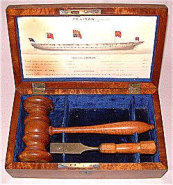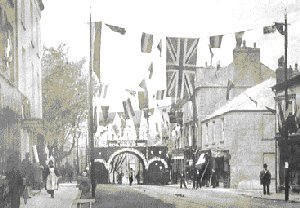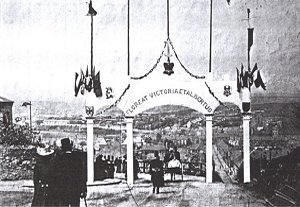
.
Launching Ceremonies
Launching day was a high point in the rhythm of community life. The shipbuilders had concentrated their
skills and energies on the creation of a new vessel, for more than a year. Now came the opportunity to
celebrate the results of their work and for the Dockyard to present its products to the world.
Some ships - particularly small ones - might be launched by ladies from eminent local families, who in
the 1850s were expected to take a bottle and "sling it violently against the the vessel's bows."
Sometimes, only modestly sized crowds attended. The launch of battleship or a Royal Yacht, on the other
hand, could be a spectacle to attract huge crowds. For HMS Repulse (1892) "thousands of excursionists
had come into the town, excursions being run from places so far distant as Cardiff and Newport". A
reporter estimated "a thundering cheer from 20,000 throats" greeted HMS Empress of India (1891) as she
left the slipway.
Dignitaries and invited guests would have places in booths and stands around the ship's bow and
elsewhere within the shed. Multitudes of the general public found other vantage points. Late arrivals
might be taunted by "a running fire of jokes and wit ... in no very subdued tones" by midshipmen perched
on the vessel. As the moment of the launch approached, excitement mounted - "several ladies have been
so overcome by their feelings as to faint at this critical moment"

Pembroke Dockyard, 1882.
The Duchess of Edinburgh launches HMS Edinburgh.
A particularly important ship might merit a Royal visit. Newspaper accounts of HMS Empress of India's launch suggest the
pace and sequence of events at a major ceremony. The Duke and Duchess of Connaught and the Duke of Edinburgh
stepped ashore from their yacht around 1 pm, to a twenty one gun salute from the Defensible Barracks and a guard of
honour. The Castlemartin Yeoman Cavalry provided their escort to the market, where the Mayor and Corporation greeted
them respectfully.
The Dockyard gates opened at 2.45 pm and the regimental band of Duke of Cornwall's Light Infantry entertained visitors
with a programme including Wagner, Weber and Strauss. Prayers were read. By 4.15 the spectators were "on the tiptoe of
excitement" as Mr Froyne, the Chief Constructor, explained the launching procedure to the Royal party. The Duchess
pressed "a button embedded in flowers", to break a bottle against the ships' bows, then severed a thin rope with a
ceremonial mallet and chisel. After a pause, "amid terrific cheering, the mighty battleship began to move gradually, got
on more way, and was soon sailing beautifully down to the water" to the strains of "Rule Britannia" and "A life on the
ocean wave".
Five hundred invited guests later attended an evening reception in the Dockyard, with another musical programme from
the regimental band.

The ceremonial chisel and
mallet would be presented, in
a case, to the lady who had
performed the ceremony. Miss
Frances Adams launched HMS
Pelican (17 guns) in 1860.
The town, as well as the Dockyard, became a place of ceremonies and decorations. For the launch of HMS Edinburgh (1882), the Duke and Duchess of
Edinburgh drove through streets festooned with "strings of evergreens [and] artificial flowers from end to end" and lined with masts "adorned with shields and
small flags". Wooden arches, with flags and bunting, spanned the streets in four places. One "bore an inscription which welcomed the Duchess of Edinburgh in
her own language" (Princess Marie was Russian). Street arches also celebrated the launch of the Royal yacht Victoria and Albert III (1899) and the privately built
Japanese warship, Hi Yei (1877)

1899 - ceremonial arches greet the Duchess of York and the Duke of Connaught


in Bush Street..
... and in Prospect Place
Such a welcome gave townspeople the opportunity to demonstrate their pride in the Dockyard and their patriotism, whilst enjoying the carnival
atmosphere. In a town whose income depended on the Dockyard and its defences, it could also be an opportunity to remind influential visitors, and
newspaper readers, of the yard's efficiency and reliability. In 1891 the Mayor respectfully points out "what a very important military station Pembroke
is". The Duke's of Connaught's reply is reassuring. He appreciates "the launching of so large and powerful a ship ... proves the great value of Pembroke
Dockyard to the country and to the Navy".
Oriental fireworks
Some launch days ended with fireworks and street illuminations. For the Hi Yei, the evening ended with pyrotechnics and "a grand general illumination,
when a procession of one thousand variegated Japanese lamps, balloons, giraffes and peacocks will be arranged by Professor Davis, chief pyrotechnist of
the Royal Gardens".
The journey home
Before the railway came, crowds of spectators would travel home by horse drawn vehicles - as described in an 1852 Tenby visitors' guide. "The scenes on
the road, during the return to Tenby, are humorous in the extreme. The numerous odd-looking things mounted on wheels ... dusted and freshened up
expressly for this day's journey, filled with merry, laughing faces of happy people ... are altogether a happy finish to the day's amusements; and a
journey to the dockyard launch cannot fail to interest and amuse any person who is in the enjoyment of health and spirits. "
(Sources: Cuttings, Pembrokeshire County Libraries; Gwynne 48-9; Mason 236-239; PTG 9 June 1877)
Pictures by courtesy of: Mrs C. Hogg - Mr Phil Carradice.


TOP
HOME
(Amendment, updates and additions) (AJ) Anndra Johnstone
This site is designed, published and hosted by CatsWebCom Community Services © 2018 part of Pembroke Dock Web Project






















